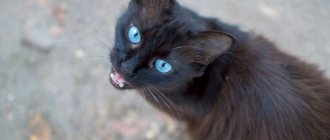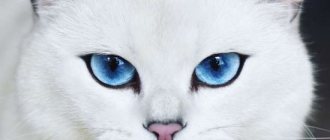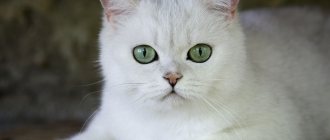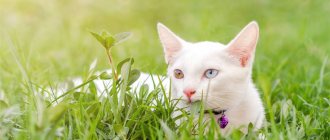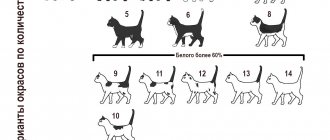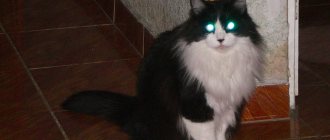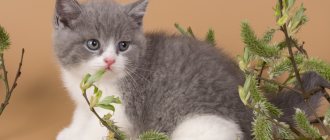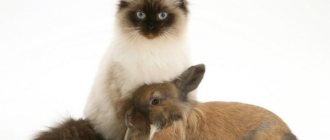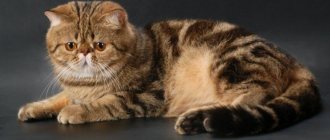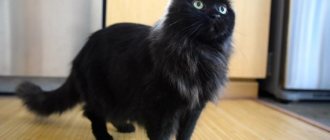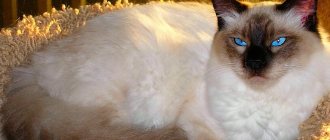4980Pavel
2
White color in the cultural traditions of any people signified purity, innocence and a new beginning. A white cat with green eyes is mentioned in ancient texts as a symbol of good news, good luck and peace. Pedantic and neat people try to have white cats; a snow-colored beauty will give harmony and comfort to the home. Any cat breed has a lot of characteristics, and cats with white fur are no exception.
Genetic studies do not provide a reliable answer to the question: does the character and behavior of pets depend on color? However, over many centuries of coexistence, people began to endow felines of a certain color with their own character. White cats are characterized by deep devotion to their owner and a calm disposition; they value comfort, silence and coziness.
© shutterstock
Naturally, different breeds of white cats differ in their habits:
Tarnished Reputation
White cats, and especially long-haired white cats, are called by breeders not for lazy people
. And this point is important to realize even before purchasing, since there is nothing more pathetic than dirty, matted fur of an indistinct shade. White cats completely ignore blind partitions, closed doors and strict prohibitions: if there is dirt in the house, she will find it, smear herself and appear before the owner, looking at him with the most innocent look
It is useless to scold, and even more so to wean the cat from exploring the territory. A white cat in the house is a serious reason to maintain perfect cleanliness.
However, you should not think that a snow-white cat is a kind of dust collector. If the pet is healthy and the owner does not forget to take care of the fur, there will be much fewer problems. As a rule, the “revealing” places are the heels, base of the tail, chest, muzzle and base of the ears. In these areas, the fur often takes on a yellowish or grayish tint, even if the house is sterilely clean. Therefore, caring for a white cat necessarily includes bathing with the use of special shampoos, pastes and powders. Cosmetics must be professional, and therefore not cheap. A cheap whitening shampoo can burn the fur and turn it a “cheerful” bluish or greenish tint.
In Ancient Rus' there was even a sign about what a white cat in a soiled fur coat means in a dream: slander, a tarnished reputation, gossip, unsightly rumors. And really, what will guests think when they see a grimy, once snow-white cat? It is doubtful that they will consider the owners to be neat, loving and caring people.
Caring for a special pet
Albinos are not recommended to be kept with other pets due to the high likelihood of infection and possible harassment from cats with normal colors. Such pets require a lot of attention, so it is much calmer not to be torn between several pets.
Feeding
Due to frequent allergies and gastrointestinal problems, the best feeding option is ready-made dry food for cats with sensitive digestion. On such a diet, the animal will receive all the necessary elements without harm to health.
It is not recommended to let your snow-white pet outside. Protect it from direct sunlight and drafts by placing it in a warm room with dim sunlight. Pay special attention to your fur coat. It gets dirty quickly, so as it gets dirty, wash your cat with a special hypoallergenic shampoo designed for animals with white fur.
For privacy and shelter from annoying guests, buy your pet a comfortable house where he can hide at any convenient time. Also, do not forget to protect him from stress by stopping quarrels inside the house.
Mating or castration?
Serious congenital anomalies appear only in kittens that received the mutant gene from both mother and father at the same time. With a standard set of genes in at least one of the parents, all offspring are born with normal color.
It is acceptable to breed an albino cat with a regular cat, but it is better to neuter an albino cat immediately. Due to weak immunity, the pet may not survive childbirth and die.
Variety of white breeds
Snow-white cats can be completely different. After all, it all depends on the breed. What types of snow-white animals do residents of our country prefer to have in their homes today? The breeds of white cats are presented below.
Turkish Angora
Very often, a white Turkish Angora cat comes across different eyes. Therefore, there is no single standard regarding eye color. On average, the weight of an adult is about 3-4 kilograms. A male can weigh up to 5 kg.
The color of such animals can be absolutely any, with the exception of brown or Himalayan color. But, naturally, the most valuable color is white. Breeders do not recommend mixing this breed with any non-white pets. Moreover, snow-white specimens are always more valuable. The fur of such an animal has no undercoat. Its length may vary. As a rule, the fur on the collar and tail is long. There should be so-called panties on the hind legs.
This breed is easy to train. White kittens are smart, well-mannered, affectionate, and quickly become attached to humans. The fur of such pets should be carefully combed. In the off-season, white. In practice, pets with different eyes often have hearing problems.
Foreign White
Foreign Whites are a type of Oriental cat. This white cat first appeared in 1965 in the USA as a result of selection. His ancestors in the Middle East can be found in almost every home. But in Europe and the USA it is not so popular. This variety should have snow-white fur, and there should not be a single sign of yellowishness on it. By the way, this color of Orientals is the only one in which the eyes should be blue. If a white cat has eyes of different colors, then such pets are often not allowed to mate.
If a kitten has eyes of different colors, it means that he received them from Oriental parents. Sometimes there are spots on the top of the head of such kittens that disappear over time.
Persian breed with blue eyes
Animals of the Persian variety can have any color. But if the animal is endowed with snow-white color, then it will have blue eyes. The fur of this pet is fluffy and very long. Such an animal requires regular brushing. The Persian blue-eyed cat has a phlegmatic character; pets become very attached to their owner.
As a result of this, they are very dependent on humans, which makes them lazier. If you don't take care of the fur, tangles will form in it. It is also necessary to wipe your cat's eyes from time to time. A white cat of the Persian breed, as a result of blockage of the lacrimal glands, needs regular eye care.
Some interesting facts about ginger seals
The appearance of a cat with fiery coloring in the house is good news. By feeding and petting the animal, the owner will ensure good luck in business and protection from misfortunes. The appearance of such a pet in the house will provide career advancement, money (income growth) and protection of the home from burglars.
If you meet one or more ginger cats on the road, you know that a bright streak in life has begun! Meeting a ginger cat with green eyes promises special luck.
Finding a small red kitten on the road is a traditional symbol of good luck in the beliefs of many peoples around the world. A person who shelters a sweet sunny wanderer will be successful in all endeavors.
White cat breeds
One of the most common breeds is the Turkish Angora - a small and elegant cat with long white hair. Her eyes can be of different shades.
These animals are intelligent, inquisitive and energetic.
They like it when all the attention is focused on them, but loneliness is scary for them. They prefer one of the owners
Foreign White is a fairly rare breed, so finding such a pet is difficult. These cats have white, very smooth and shiny fur. They are elegant, always confident and even mysterious.
The white Turkish Van most often has spots of a different color on his coat: on the tail, head, and muzzle.
The Thai cat Khao Mani was born more than a century ago. Kittens are born with spots, but they disappear with age. These cats love their owners and follow them everywhere. They are curious, intelligent and playful.
Some breeds also produce snow-white kittens. For example, white Persians are very rare, which is why they are highly prized.
Features of color
Felinologists attribute the red color to the reddish shades of cat fur. This color appears as a result of mutation. Geneticists have discovered the O chromosome, which is responsible for the appearance of kittens with this shade of fur. According to statistics, many more sun seals are born than females with red fur. The pattern in the form of stripes and pigment spots on the pet’s fur is individual in nature and is never repeated.
Characteristics of black and white cats
Despite the fact that felinology experts do not identify any features of the temperament or behavior of cats associated with their color (these are rather breed nuances), owners of black and white pets claim that they have many interesting features.
Thus, people who keep two or more cats, one of which is black and white, believe that two-colored pets are more docile and affectionate. According to the owners, black and white cats received their ideal character from their monochromatic (black and snow-white) ancestors. It is commonly believed that snow-white cats have angelic gentleness and tractability, while black cats, on the contrary, are strong-willed and independent. A “mix” of these colors produces gentle, but independent cats.
It is believed that black and white cats “inherit” the character of pure white and black cats.
Black and white cats are credited with another feature - they get along well with people, conquering them at first sight. Animals of the “black bicolor” color subtly sense a person, guess his mood, therefore they never impose themselves once again, but are always ready to communicate
Perhaps the friendly disposition is due to the fact that two-color cats look very cute, and the people who get them treat their pets with great tenderness and attention
Cats and health
Red cats are often called house doctors. These pets can alleviate the condition of a sick person. There is a belief that orange cats prevent the owner from excessive addiction to strong drinks. Thanks to the optimistic attitude that cats with solar energy give, their owners feel the will to live and are in a positive mood. This effect is especially useful for people suffering from unstable blood pressure or migraine attacks.
Norwegian Forest Cat
The exact origin of this breed is still unknown. In any case, the ancestors of cats roamed Norway and interbred with wild representatives. The description of the Norwegian forest cat should begin with the fact that representatives of this breed are considered the kindest and friendliest. It would be difficult to find more loving creatures in the cat world. Pets love people and animals. Norwegians have different colors. White cats look very beautiful. Their fur is as pure as snow. These are the animals that have blue or blue eyes.
Norwegians were brought to America only in the eighties of the last century. And in Russia they started talking about them in the nineties. Representatives of the breed are large in size. Animals are excellent climbers due to their good physical properties. Pets' fur is long and warm, it has a thick undercoat and water-repellent properties. The animals have a long fluffy tail and beautiful tufts on their ears. This breed of white fluffy cats is very beautiful.
Breeds of black and white cats
For a long time, the black and white color remained unrecognized by felinological systems, and purebred cats with a similar color were mercilessly discarded. The situation changed in 1969, when animals with such coats first appeared at the exhibition. Now black and white cats are found in many breeds.
British
For a long period, only blue or smoky colors were cultivated in the breed. But with the popularization of the British, their color range expanded significantly.
In addition to the standard types - van, harlequin and bicolor - among the black and white cats of this breed there are individuals with the unrecognized mitted color. It requires the presence of a light stripe between the chin and groin.
Also, black and white cats of the British breed with a mitted color should have light “socks” or “socks” on their paws.
Oriental
The standard of this breed provides for more than 200 colors, including all black and white variants. Moreover, a van, bicolor and harlequin kitten can be born in one litter. There are many varieties of black and white cats in the breed.
Among the Orientals there are also charcoal individuals with light paws and markings on the face, and snow-white animals with small contrasting spots.
Canadian Sphynx
Bicolor cats are often found among cats of this breed. Moreover, a contrasting pigment colors the skin. Black and white cats of this breed often have a charcoal tail and at least one ear. Sphynx cats are also allowed a symmetrical dark marking on the top of their head.
Kurilian and Japanese bobtails
These tailless cats also have a black and white color, which is characterized by certain features. Bicolors must have a closed white collar on the neck and a light marking on the muzzle in the shape of an inverted V.
Harlequins should have charcoal spots on the forelegs, back and head. Black and white van bobtails have a dark tail and a completely light back.
Kurilian BobtailJapanese Bobtail
Maine Coon
These large cats can be black and white in color. Moreover, they are more characterized by the bicolor type, in which most of the body, including the muzzle and ears, is covered in charcoal color.
Among the black and white Maine Coon cats, there are almost no individuals with the “van” and “harlequin” colors, so the cost of such animals can reach several hundred thousand rubles.
Persian
The most common color found in black and white Persian cats is the “harlequin” color, in which 5/6 of the body surface is lightly pigmented. The rest of the body is covered in a rich, cool charcoal color.
For the Persian cat breed, dark whiskers and white hairs on black spots are unacceptable.
Siberian
In addition to the usual variegated colors, the breed allows more than a dozen different colors, including a black and white version. Moreover, a fluffy Siberian can have all three types with clearly defined spots that do not overlap with each other.
The eyes of a black and white cat of this breed are pigmented yellow or green.
Turkish Angora
Although many believe that the Angora is a pure white cat, it also has other color variations. The bicolor breed has light legs, chest, collar, muzzle and belly, as well as a white mark on the forehead that looks like an inverted V.
Manx and Cymric
Tailless cats have many color options, including black and white.
ManxKymric
Munchkin
These cute, short-legged cats can have black and white fur. Bicolor munchkins often have light markings on their faces, “socks” on their paws, a “collar” on their necks, and a “tie” on their chests.
Cornish Rex
This figurine-like curly cat also comes in black and white. Moreover, in addition to the three main color options, the breed allows the “tuxedo” color, in which the Cornish’s chest, paws and belly are light, and the top of the head, back, shoulders and sides are charcoal.
The iris of a Rex black and white cat can be blue, yellow, olive or copper.
Turkish van
From the name of the breed it is easy to guess which type of coloring is inherent in these cats. Black and white Turkish Vans have a light body with small dark markings on the head and a charcoal tail.
Turkish Angora
Incredible charm and charismatic character - this is exactly the combination that owners will receive if they decide to get a Turkish Angora cat.
A little background
The Turkish breed is an indigenous cat species that is more than several centuries old. The first representatives of the tribe were the furry inhabitants of Turkey. Until the 16th century, a kitten of this breed was considered the most expensive gift presented to the Sultan. Later, the breed conquered Europe, winning the hearts of cat lovers.
The world learned about the Turkish Angora thanks to the Russian-Turkish war
Breed standard
Today, the Turkish Angora remains popular. The main features of its exterior are presented in the table.
Table 1. Turkish Angora: breed standard
| Parameter | Details |
| Body type | Lean, muscular, slender |
| Limbs | Long, graceful, with rounded paws |
| Tail | Long, tapering to the tip |
| Head | Wedge-shaped, medium size. The muzzle is narrow |
| Wool | Fine, medium length, no undercoat |
| Color | Any options are allowed except chocolate; lilac, cinnamon, fawn color. |
The classic color of the Turkish Angora is white. Some inclusions of contrasting colors, such as red or black, are also allowed. However, the snow-white version remains the most revered. In addition to its color, the Turkish Angora is valued for its grace, aristocratic habits and capricious character.
Color options with colored splashes are quite rare
Character
Despite the apparent aloofness of the white-haired Angora, it conceals within itself the most tender soul of an exquisite cat. This pet will not tolerate rudeness and disrespect towards itself. From the first days of their stay in the house, representatives of the breed determine their status, which the owners will follow without even knowing it.
When getting a Turkish Angora, remember that she will want to be the center of attention all the time.
Turkish cats are very curious. They care about everything that happens in the house. Therefore, attempts to limit the inquisitive mind of your pet with closed doors will fail. Angoras are touchy. The greatest damage to their tremulous consciousness is caused by ignorance. Representatives of the breed will never accept the role of sofa decoration. This fact should be taken into account by those who are looking for a beautiful cat, but cannot pay enough attention to it.
Angora cats are restless, they will not like a monotonous lifestyle
Attitude towards children
In a home where there are children, safety instructions should be given before purchasing a cat. For only in peaceful conditions will the Angora become a true friend for the baby. She will not tolerate encroachments on her freedom, as well as on her tail, so she is suitable as a companion, but not as a nanny.
When communicating with children, representatives of the breed can allow themselves to be excessively harsh.
The willful and refined Turkish Angora will become a faithful pet for those who respect the cat's disposition and its quirks.
Character
First of all, it is important to remember that, despite the fact that all gray-white cats are united by color, they themselves are individual animals that are not similar to each other. Therefore, the character and behavior of one cat may differ significantly from these indicators in another.
It is easiest to predict and analyze the character of purebred animals, because they are well researched and studied by scientists. It is much more difficult to judge the character of yard gray-white cats.
Despite this diversity, many owners of gray-white cats still highlight some similar features of these animals. Thus, in terms of their behavioral patterns, such pets are quite calm and docile. Some of them may show increased activity and playfulness, but such characteristics are due to the characteristics of a particular breed.
Therefore, you should not show unreasonable aggression and anger towards your pet. In addition, such animals are easy to train and learn; they quickly begin to use the tray and know their place. Such signs are due, first of all, to the high intellectual abilities that nature has endowed gray-white furry pets with.
Microclimate inside the house
A pet carrying energy with a “plus” sign has a beneficial effect on the relationship between family members, absorbing negativity and aggression.
A colored cat with red hues is designed to protect people from evil influences. Biologists explain the pet's desire to rub against its owner's legs by behavioral instincts. In fact, this behavior is a ritual of protection against damage and the evil eye. Domestic cats are very sensitive to outside influences and are able to neutralize negativity.
Here are a few folk signs that help explain the behavior of a pet from an esoteric point of view:
- The warm nose of a pet indicates the machinations of ill-wishers.
- A cat's calm mood portends a successful day.
- A kitten's nervous (angry, sad) mood should be regarded as a warning.
- A cat girl playing with her paws while sleeping fights evil spirits.
Those who like to “go left” should remember that cats are well aware of adultery. The animal will not be able to tell your other half about the problems, but it will signal it with hissing and an unkind attitude.
What do Russian blue cats look like?
The northern city of Arkhangelsk is considered the birthplace of this breed. It was from there that, at the end of the 19th century, an English breeder took out a couple of animals, which are believed to have marked the beginning of breeding. During wartime in the first half of the 20th century, the breed was almost on the verge of extinction. Crossing with Siamese and other cats helped save her.
Russian Blues are very graceful cats. Photo: Dizfoto/Depositphotos
Russian Blue cats are medium-sized animals. The body is graceful, but at the same time strong and quite muscular. The tail is long. The head is not too large, proportional to the size of the body. The eyes are large and oval, green, and the color is finally established by the end of the first year of life.
The coat of the breed is short, dense, silky and almost plush to the touch. The axial hair in it is approximately the same length as the undercoat. The color is uniform gray-blue with a silver tint.
Turkish Angora
Features of the White Angora breed of animals are:
- white color;
- fluffy tail;
- lush wool;
- blue or multi-colored eyes.
Cats have a medium-sized body and well-developed muscles. On a wedge-shaped head of medium length, ears are set high with sharp tips. They are well pubescent inside, although they appear almost transparent.
The animal's fur is medium in length and fine in texture. There is no undercoat. The guard hair is shiny and strong to the touch.
Turkish Angora cats do not like to be left alone at home. They are friendly, energetic, affectionate, and curious. They have a high level of intelligence and love procedures in water.
